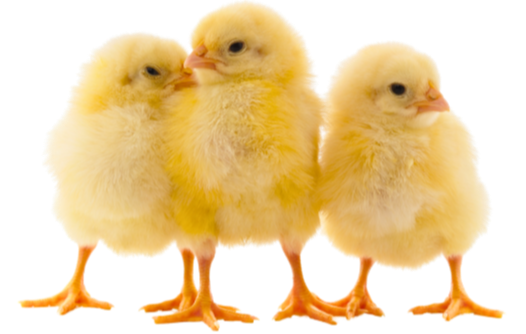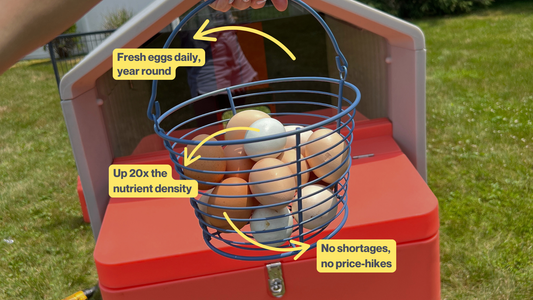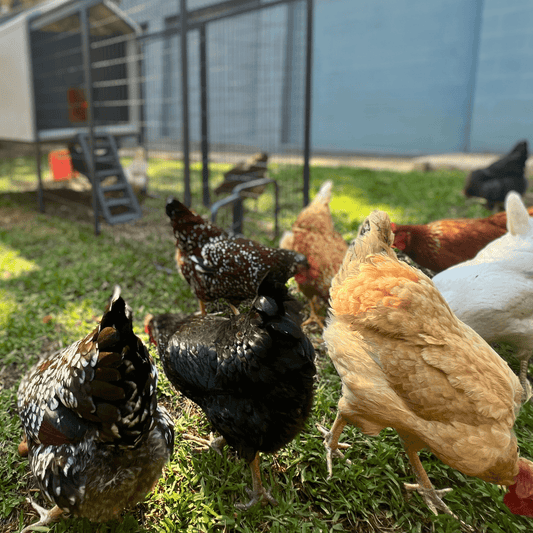
Why Backyard Chickens Are the Perfect First Step Into Your Mini At-Home Farm
A practical, joyful way to spend more time outside — together.
There’s a shift happening. Parents are rethinking screen time, craving more time outside, and asking bigger questions about food, habits, and connection. But the answer doesn’t have to be a full homestead or a 5 a.m. garden club. Sometimes, it’s as simple as a small coop in the backyard and a handful of hens your kids named themselves.
Backyard chickens create rhythm. They bring kids outside in the morning and again in the evening. They teach patience (you don’t get eggs every time you look), gentleness, and the idea that food comes from somewhere — not just something.
And they give back. In food, yes. But also in presence.
This isn’t about doing it all. It’s about doing one thing that matters.
What You Actually Need (And Don’t)
Let’s strip it down to what actually works for families who are interested — but cautious.
🏡 Space
You don’t need acreage. You need a safe coop with a secure run, a patch of dirt or grass, and enough space for 3–6 hens to roam comfortably. Even small suburban backyards are enough.
🐓 Breed
Look for friendly, easygoing breeds that do well with families:
-
Buff Orpingtons – calm, fluffy, and easy to handle
-
Australorps – social, hardy, and consistent layers
-
Barred Rocks – great personalities, adaptable, and beautiful
These birds are known for being good with kids and low-drama in the backyard.
🍽 Feed + Water
Chickens eat a mix of:
-
Layer feed (available at most feed stores or online)
-
Table scraps (more on this next)
-
Grains or treats like cracked corn or mealworms
Water should be clean and available at all times — refilling it daily becomes a perfect kid chore.
🧼 Clean-Up
How often you clean depends on your setup. The easier the system, the more likely your kids will stay involved.
-
With basic coops, you’ll be raking or shoveling weekly.
-
With a Smart Coop, droppings fall through slatted floors and dry out naturally — which means far less smell, no soggy mess, and no scraping.
Modern coops like this also have light sensors to open/close doors, built-in cameras for checking in, and an app that lets you monitor from anywhere. It’s not about tech for the sake of tech — it’s about making it doable.
♻️ The Waste Loop That Actually Works
The average family throws out 250 pounds of food per year.
The average adult chicken eats about 9 pounds of food per month.
Now do the math — that’s a built-in, feathered composting team.
Chickens eat:
-
Curry leftovers
-
Stale bread
-
Wilted kale
-
Banana peels
-
That weird slice of lunchbox apple nobody finished
And in return? You get nutrient-rich, golden-yolked eggs — with no plastic packaging or supply chain. It’s one of the few parenting “hacks” that’s good for your kid, your conscience, and your carbon footprint.
This is where kids really light up: they start noticing what’s compostable, offering scraps to the hens like they’re honored guests, and connecting the dots between what we waste and what we grow.
No guilt. No bins. Just a loop that feeds itself.
Where Kids Fit In: Age-by-Age Tasks and Joys
Chickens aren’t just around your kids — they give your kids something to care for, something to talk about, and something to return to. And the magic isn’t just in collecting eggs. It’s in the rhythm. The tiny routines. The moments that sneak up and stay.
Here’s what that can actually look like by age:
👶 Toddlers (2–3)
-
Observation: Sitting on a lap, watching hens scratch in the dirt
-
Sensory connection: Holding a warm egg. Dropping lettuce into the run.
-
Mini-chores: Filling a small cup of feed to sprinkle under supervision
-
Language & bonding: Learning names, mimicking sounds, waving goodnight to the flock
These small, slow moments become real anchors — a gentle way to start fostering care and consistency.
🧒 Preschoolers (4–5)
-
Egg collecting: With guidance, they can check the nesting box each morning
-
Helping refill water: Especially with smaller waterers or parent-handled jugs
-
Treat time: Offering greens, grains, or scraps — a highlight of the day
-
Naming & storytelling: Expect chickens to get full personalities, backstories, and sibling rivalries
This age loves routine — and chickens deliver it beautifully.
👧 Elementary Age (6–10)
-
Morning and evening checks: Opening the coop app to see when the hens go in for the night
-
Refilling feeders independently
-
Light cleaning: Raking, sweeping, composting bedding — especially with a simplified setup
-
Record keeping: “Egg logs,” chore checklists, and maybe even a chicken-themed journal
This is often when kids take full ownership. The hens become their hens. The routine becomes theirs too.
👦 Middle Schoolers (11–13)
-
Full coop maintenance: Weekly deep cleans, minor repairs, safety checks
-
Research and care: Choosing new breeds, understanding molting, monitoring behavior
-
Garden integration: Planning what to plant next to the coop and why
-
Tech interest: Engaging with the app, CoopCam footage, sensor data, and routines
They may not admit it, but this becomes a quiet form of pride — a job they manage, a space that’s theirs.
The Bigger Payoff (That Has Nothing to Do With Eggs)
At first, it’s about the novelty. The first egg. The first time your child carries the feeder out on their own. The proud moment they remember every chicken’s name — and give three more to the same bird.
But then something deeper sets in. A rhythm. A sense of care.
💡 More Time Outside, Without Needing a Reason
There’s no fight to get out the door when there are chickens to check on. No need to invent a craft or a theme — just real things happening in real time, outside.
Your child starts noticing things: how early the hens come out when the days get longer. Which greens grow faster in full sun. How a quiet presence can calm an entire flock.
They move slower. They listen more. They come back out even when they don’t have to.
🧠 Responsibility That Feels Real (Not Assigned)
There’s a difference between a chore and a choice. Kids know it. You know it.
The beauty of backyard farming is that the responsibility feels real — and they feel needed. The hens won’t eat if no one feeds them. The garden won’t grow if no one waters it. They’re not just helping you — they’re caring for something that depends on them.
That’s where confidence builds. That’s where independence begins to feel safe, not scary.
❤️ A Sense of Ownership, Stewardship, and Quiet Pride
Something shifts when kids feel ownership over a space. When it’s theirs to care for. When they walk a neighbor out back to show off the garden, or open the coop app on their iPad just to check in.
You’ll hear it in the way they talk.
“She laid an egg!”
“Those are our tomatoes.”
“Let me show you her favorite spot.”
This is what makes it last. Not just eggs, not just dirt, but something your family built — together.
🧠 Smart Parent Wins
Let’s be honest — your family doesn’t need one more thing to maintain. So when it comes to keeping this whole rhythm going, the tools matter. A modern setup doesn’t just make chicken keeping easier — it makes it more likely your kids stay involved.
Here’s what makes a difference (without turning this into a tech demo):
-
Two built-in CoopCams
Your kids can check on their flock from a tablet before school. You can peek in without disturbing the hens. It quietly becomes a new kind of family ritual. -
Light-sensor door with app control
You’ll never have to sprint outside at dusk or worry if someone remembered to close the door. The app shows when the flock is safely in for the night — and turns bedtime check-ins into something everyone looks forward to. -
Auto-clean floor design
Droppings fall through slatted flooring and dry naturally — meaning fewer chores for you, more independence for them, and no battles over who has to “scoop poop.”
These are the little things that help keep it joyful — and sustainable.
Thinking About Getting Started?
If this sounds like something your family might grow into, you don’t have to go all in overnight. You can start small. Three hens. A sunny spot. A simple routine.
But if you are ready to take the leap, here’s the setup we’d trust in our own backyard:
a secure, well-ventilated coop that’s kid-accessible, weatherproof, easy to clean, and lets your family focus on what matters — not managing the mess.
Because raising chickens isn’t really about chickens. It’s about mornings that start a little slower. Evenings that end with a quiet check on the flock. And watching your kids fall in love with something real.






